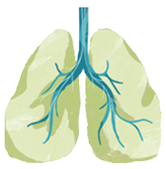Bronchiectasis (brong-kee-ek-tuh-suhs), or BE, is a chronic inflammatory lung disease
Bronchiectasis widens the airways, making it difficult to clear mucus and bacteria. It’s progressive, meaning it can get worse over time, and it can lead to permanent lung damage.
How is BE diagnosed?
The lung damage from BE is visible on a CT scan, with airways appearing widened. To diagnose BE, a pulmonologist will review your symptoms and may recommend a CT scan if BE is suspected.
BE symptoms can include:
Chronic cough
Excess mucus
Shortness of breath
Fatigue
Because many BE symptoms are similar to other conditions, it can sometimes take time to get a diagnosis.
Bronchiectasis flares and what they mean for your health
If your BE symptoms worsen, it may be a sign that you’re experiencing a BE flare, or exacerbation, as your doctor may call it.
A single BE flare can last up to a month and may have a serious impact on your physical and emotional well-being. Flares can:
Make symptoms like coughing, shortness of breath, and fatigue worse
Lead to more flares
Lead to a loss of lung function
That’s why proactively reducing flares is an important part of managing BE.
